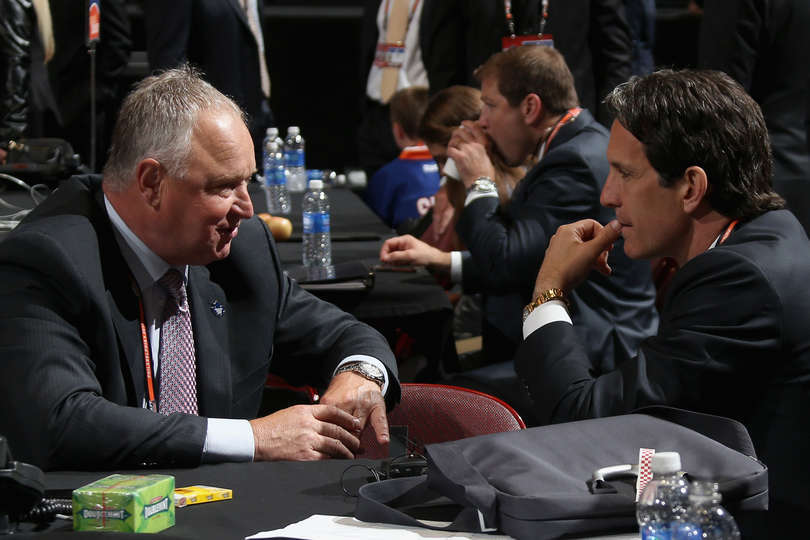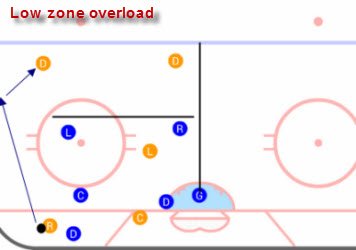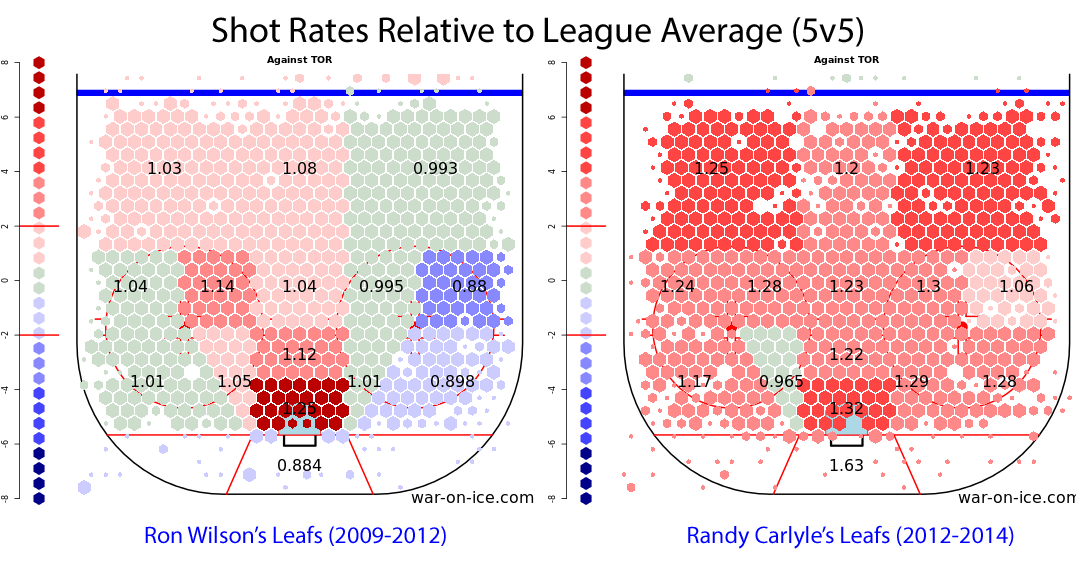Most fans had Randy Carlyle fired before the 2013-14 season ended. He wasn’t.
Instead, Toronto’s front office opted to extend the former Norris trophy winner. Quotables citing Carlyle’s experience and Stanley Cup-winning pedigree have been bandied about as support. Even his detractors are unlikely to admit his retention immediately spells the end of this year’s playoff hopes. But a failure to significantly overhaul his defensive system of the past two seasons is likely to do exactly that.
By now, you’re all familiar with the infamous “swarm” tactic that the Leafs have employed (unsuccessfully) since the beginning of the 2012 season. Many recognize it as a flurry of frantic and futile flailing displayed by this Toronto squad in their own end. The concept – and its shortcomings – were best summarized here on MLHS by Gus Katsaros.
[pull_quote_center]It is common knowledge that Carlyle prefers a system which collapses forwards down low, while attempting to cut the ice in half, forcing an overload, which carries a risk of open space if the puck gets to the other side. This contributes to additional zone time when the opposition applies pressure, especially along the boards, an area that’s been difficult for the Leafs.
One of the drawbacks of having forwards so low is what I refer to as ‘the accordion.’ If I am an opposition coach, I would get the puck in deep (even as a dump in play), force the natural collapse of forwards and get the puck back to the point, forcing the defending forwards to turn around and get out there quick.
If there is a clear shot on goal, low-zone forwards converge to the net. If there isn’t a direct shot to the net, the puck can be sent back down low and have the process start again, collapsing the forwards and kind of playing them like an accordion. Not only does this tire out the defending team, it creates holes and passing lanes in the middle of the ice that can be used as additional space for the attacking team forwards to encroach looking for a better position for a shot on goal.[/pull_quote_center]
One would think that a strict adherence to a clearly faulty system would be a thing of the past. In the fishbowl of analysis and criticism that is Toronto, many have suggested that Carlyle’s system doesn’t work and needs to change. This notion has been broached by the media, fans and even his own players.
From the outside, it appears just about everyone is on board with a systemic overhaul except the few people with the power to actually do it. Earlier this summer, Alec sat down with Steve Spott for an in-depth interview. While the hiring of Peter Horachek to help run the defense pairings seems like a step in the right direction, questions concerning the swarm revealed that the best we can hope for is “adjustments:”
[pull_quote_center]We had a couple of minor adjustments we implemented into that swarm… some different rules of when we would go into it. I’m hoping those are some of the rules we can work in with the Leafs this year, where we can make some small adjustments to it.[/pull_quote_center]
In fact, it seems that Carlyle himself is convinced that it was simply a matter of “will and commitment” that saw his club set an all-time NHL record for most shots against.
[pull_quote_center]You have to play and you have to compete on the defensive side of the puck with will and commitment, and we did not want to do that on a day-to-day basis. That’s where our struggles were.[/pull_quote_center]
One has to wonder if Carlyle truly believes this. A quick glance at Toronto’s Hextally charts under Carlyle’s reign versus the Ron Wilson era paints a very clear picture of the repercussions of Carlyle’s defensive scheme. Perhaps he still believes in the myths of the lockout season: that letting opponents fire at will from the point keeps the shots to a distance, shots his goalies should be able to stop.
As per Elliot Friedman, Carlyle has maintained this stance for years:
[pull_quote_center]Ryan said there was one on-ice adjustment with his transition from Anaheim to Ottawa. Senators head coach Paul MacLean wants his forwards to engage opponents who go to the half-wall with the puck in the defensive zone. Ryan remembers then-Ducks head coach Randy Carlyle demanding they stay in the middle of the ice. ‘If the goalie can’t stop it from out there, we’ll get another one,’ Ryan said Carlyle would say.[/pull_quote_center]
For those of you not familiar with the Hextally charts (courtesy of war-on-ice), they display shooting rates relative to the league average by location. A value of 1 is exactly the league average. The colour of the hex indicates the statistical significance of the value.
Ironically, the Leafs were noticeably better at limiting shots against under the “free wheeling” Ron Wilson system. Most values were not significantly different from the league average. Noticeable exceptions include the slot area and a startling amount of shots against from directly in front of the net.
Compare that to Carlyle, purportedly a strong “defensive coach” who saw a relatively small turnover in personnel in his first full season in charge. It’s true the Leafs under Carlyle last season “limited” shots to the outside to the tune of nearly 125% of the league average. But, as Gus pointed out, the holes and passing lanes in the middle of the ice exposed by this system were relentlessly exploited by the opposition. The end result? Statistically significant elevated shot rates against in virtually all areas of the ice. This includes an even higher rate of shots from in front of the net than the “run and gun” Wilson Leafs.
What does this all mean? There has been a lot of optimism surrounding the continued growth of Gardiner and Rielly. There are potentially some better fits in Robidas and Polak on the blueline this year to help alleviate the defensive responsibilities of Phaneuf. Youth and depth replacements are plentiful with names such as Granberg, Percy and Holzer being thrown around with good cause. There is essentially a rebuilt supporting cast at forward.
But, truthfully, we have to mitigate any optimism with the reality that not much will change if Carlyle doesn’t. With the collective weight and frustration of Leafs Nation bearing down on them, the impetus is on the coaching staff to drastically alter their system. Minor adjustments and vague implications that the players simply need to “compete” more may not rectify the magnitudes of the struggles within Carlyle’s defensive scheme in Toronto. Preseason is right around the corner and this will be one of, if not the, biggest question marks entering 2014-15.
































![Craig Berube Post Game, Leafs 6 vs. Sabres 3: “Our team played really hard in front of [Murray]… They were dialed in for him” Craig Berube, Toronto Maple Leafs head coach](https://mapleleafshotstove.com/wp-content/uploads/2024/12/berube-leafs-tor-pg-100x70.jpg)


